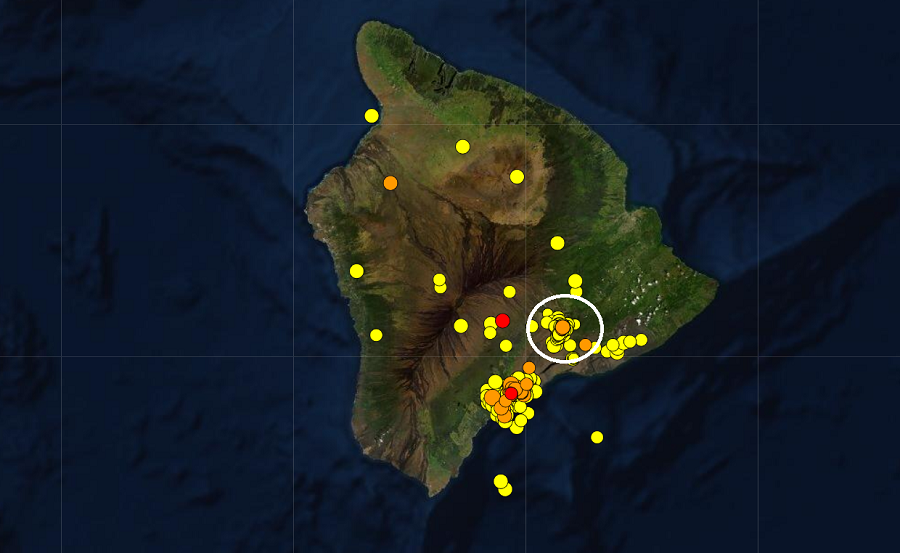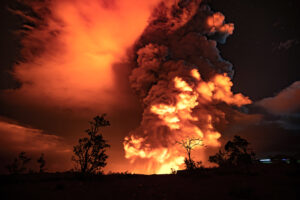
More than 600 earthquakes have rocked the Big Island of Hawaii in the last week, with more than 300 of the earthquakes tied to a swarm that impacted the area around the Kilauea Volcano. While seismic activity was busy on Tuesday and Wednesday, the activity has since dropped off. Because of the reduced activity, the Hawaiian Volcano Observatory (HVO) and the USGS scientists there have decided to change the alert / color code level Kilauea Volcano on Hawaii’s Big Island to YELLOW/ ADVISORY today. Earlier this week, it had been elevated to ORANGE / WATCH due to the dramatic increase in seismic activity there.

Kilauea last erupted in December after a long pause that followed the 2018 Lower East Rift Zone Eruption period. That eruption period ended in May, with no lava leaving the main caldera at the summit.
Scientists believe if fresh lava activity with Kilauea resurfaces in the coming days, it will likely remain inside Hawaii Volcanoes National Park and not move into private property like it did in 2018. However, HVO / USGS scientists will continue to monitor the situation closely so residents and visitors to Kilauea and beyond are kept safe from the increasing seismic activity there.
USGS equipment detected an increase in earthquake activity beneath the south part of Kīlauea summit caldera, within Hawaiʻi Volcanoes National Park, within the last 24 hours. The activity began around 4:30 pm HT on August 23 and continued through the night and into the early morning of August 24, 2021. At about 1:30 am this morning, the swarm of earthquakes intensified in this region and was accompanied by an increase in the rate of ground deformation recorded by the Sandhill tiltmeter, just to the west of the earthquake swarm location. “These observations may indicate a small dike intrusion of magma occurring 0.6-1.2 miles beneath the south caldera,” HVO said in an update this morning. “Over 100 earthquakes have been recorded as of 2:30 am on August 24; the largest recorded earthquake was magnitude 3.3 with the majority of earthquakes less than magnitude 1. Small earthquakes are continuing at a rate of at least 10 detected earthquakes per hour. Currently, webcams show no evidence of lava at the surface.” HVO added that their scientists will continue to monitor the situation and will issue additional messages and alert level changes as warranted by changing activity.
HVO is responsible for issuing Aviation Codes and Volcanic Activity Alert Levels. Aviation Codes are green, yellow, orange, or red. When ground-based instrumentation is insufficient to establish that a volcano is at a typical background level of activity, it is simply “unassigned.” While green means typical activity associated with a non-eruptive state, yellow means a volcano is exhibiting signs of elevated unrest above known background levels. When a volcano exhibits heightened or escalating unrest with the increased potential of eruption, it jumps to orange. Finally, when an eruption is imminent with significant emission of volcanic ash expected in the atmosphere or an eruption is underway with significant emission of volcanic ash into the atmosphere, the code becomes red. Volcanic Activity Alert levels are normal, advisory, watch, or warning. As with aviation codes, if data is insufficient, it is simply labeled as “unassigned.” When the volcano is at typical background activity in a non-eruptive state, it is considered normal. If the volcano exhibits signs of elevated unrest above background level, an advisory is issued. If a volcano exhibits heightened or escalating unrest, a watch is issued while a warning is issued when a hazardous eruption is imminent.
In an update released today by the HVO with regards to the new alert change, they said, “The earthquake swarm was accompanied by change in the rate and style of ground deformation. Ground deformation in the Kīlauea summit region has leveled off within the past 24 hours and rapid inflation near the region of Kīlauea’s south caldera is no longer being observed. Earthquake activity and ground deformation have decreased together to levels that indicate magma is no longer moving into the region of Kīlauea’s south caldera. These changes indicate reduced potential for an eruption at this time.”
With the reduction in activity at Kilauea, HVO has set the volcano to a YELLOW aviation code and an ADVISORY volcanic activity alert level. Nearby Mauna Loa, considered to be the world’s largest active volcano is also at YELLOW / ADVISORY for now.